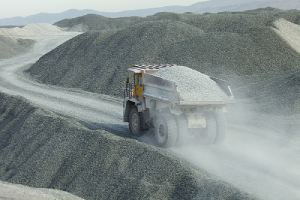 Using the right materials is one of the most important aspects of ensuring a successful and long-lasting construction project. In the construction industry, one of the most widely used raw assets is crushed stone, which can be used on its own or as an aggregate.
Using the right materials is one of the most important aspects of ensuring a successful and long-lasting construction project. In the construction industry, one of the most widely used raw assets is crushed stone, which can be used on its own or as an aggregate.
Aggregates are often used as a reinforcement to give composite materials like concrete additional strength. They encompass a wide range of fine and coarse particulate material including gravel, sand, slag, crushed stone, geosynthetic aggregates and recycled concrete. They are generally made from mining the stone and crushing it, or by crushing demolished concrete structures and pads.
Gravel, stones and other aggregates are generally categorized into one of three groups. Fine aggregate is material that will pass through a 4.75 millimeter IS sieve. Two popular forms of fine aggregate are concrete and masonry sand. Within the category of fine aggregate, there are four types of grading ranging from 1 through 4, with zone 4 representing the finest material.
Coarse aggregate is the middle category of aggregate, and it may be crushed, partially crushed or uncrushed stone or gravel. It will be described by a grade, with ¾-inch nominal graded aggregate indicating that most of the pieces will pass through a ¾-inch sieve. There are 13 standard sieves used for measuring coarse aggregate that range from number 16 to 4 inches.
Finally, all-in aggregate contains a proportion of material in a wide variety of sizes. It may come from a riverbed, crushing plant or pit and is also known as ballast. This type of material is the preferred type for repairing pavement foundations and small cracks.
Why Is It Called #57 Stone?
 #57 stone is a coarse aggregate. Coarse aggregates use grading that ranges from 1 to 8. The #1 aggregate has a nominal size of 3.5 to 1.5 inches, while the #8 aggregate has a nominal size of 3/8 to .094 inch. #57 aggregate gets its name because it is a combination of the #5 and #7 aggregates, which means that its individual pieces range in size from 1 to 0.19 inch.
#57 stone is a coarse aggregate. Coarse aggregates use grading that ranges from 1 to 8. The #1 aggregate has a nominal size of 3.5 to 1.5 inches, while the #8 aggregate has a nominal size of 3/8 to .094 inch. #57 aggregate gets its name because it is a combination of the #5 and #7 aggregates, which means that its individual pieces range in size from 1 to 0.19 inch.
What Is #57 Stone Made Of?
A coarse aggregate #57 stone can be made from durable and solid natural materials including gravel, sandstone, limestone and granite. It is a great choice for mixing concrete and asphalt and can also be used for landscaping.
It can also be mixed with #411 stone, which is essentially a type of stone dust. This combination is often used for retaining walls, creating road bases and patching holes in paved areas.
#57 stone is also a great choice for driveways that are left unpaved. The stones’ angular and irregular shapes mean they can easily mesh together on flat surfaces and retain the shape to yield a fairly stable unpaved surface for cars to travel along.
This stone may also be used for pipe bedding, drainage gravel, construction site entrances and pavement. When it is used for drainage, irrigation and bedding, it is normally derived from concrete. However, the more decorative varieties of #57 stone tend to come from more attractive materials, such as granite.
Gravel tends to be less angular because it is created naturally by erosion, but crushed stone is taken from natural rock deposits and tends to be angular and jagged in shape. It is made during a mining process from a suitable rock formation by using a crusher to break it down into various sizes.
What Size Does #57 Stone Come In?
Generally speaking, the size of #57 stone is between 3/8 of an inch and one inch. However, the way that sieve mechanisms are set up can sometimes mean that there will be a few slightly larger or smaller pieces mixed in as well.
#57 stone typically has many individual stones that are roughly the same size as nickels and quarters. When estimating the amount of #57 crushed stone a particular project will need, there are a few measurements to keep in mind. For covering a 2-inch layer across 100 square feet, about 0.62 cubic yards are needed; a cubic yard of this material equals 1.2 tons. For covering a 5-inch layer across 100 square feet, around 1.54 cubic yards will be needed.
How Can I Buy #57 Stone?
 Buying #57 stone is made easy thanks to the user-friendly Dirt Connections Portal. Upon entering the site, professional builders and homeowners can enter their street address to view the products that can be delivered to their area and find out about the availability of #57 stone.
Buying #57 stone is made easy thanks to the user-friendly Dirt Connections Portal. Upon entering the site, professional builders and homeowners can enter their street address to view the products that can be delivered to their area and find out about the availability of #57 stone.
A pull-down menu allows potential buyers to check the pricing of various numbers of truckloads of #57 stone as well as other materials, such as screened and unscreened fill dirt, unscreened organic topsoil, screened asphalt millings, 21A gravel and #3 stone.
As a general guide, one truckload equals approximately 10 to 12 cubic yards. A pulldown menu will list the prices of various truckloads, ranging from half a truckload to 10 truckloads in increments of half a truckload. Those who are ordering larger quantities of #57 stone can take advantage of more economical bulk pricing. After choosing the material needed, all that buyers have to do is enter their personal information and check out.
Dirt Connections offers quotes free of charge, and there is also a helpful video to illustrate how the process works.
Speak With A Commercial Construction Contractor
No matter what type of rocks or dirt you need for your construction project, Dirt Connections has you covered. With a wide offering of screened and unscreened fill dirt, organic topsoil, asphalt millings and stone and gravel in a broad range of sizes, their portal makes it easy to get pricing and arrange delivery.
If you have any questions about the right material for your job or how the process works, get in touch with Dirt Connections at (703) 940-9949. Their friendly staff will be happy to listen to your requirements, explain what to expect and provide further details about the products and services they offer.




